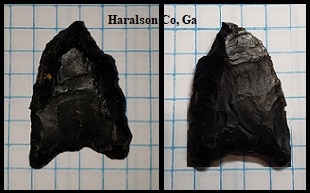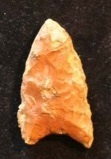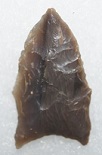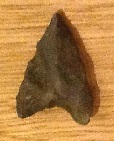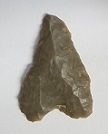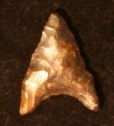Name Details:
Named By: Ripley P. Bullen
Named For:
Date Identified: 1975
Type Site:
Marianne
(Exhausted Dalton)
Cluster:
Commonly Utilized Material:
10,000 -8,500 B.P.
Transitional Paleo
Early Holocene
Date:
Cultural Period:
Glacial Period:
Culture:
Outline is Representative of Size and Shape:
Description of Physical Characteristics and Flaking Pattern:
This is a small to medium
triangular point with an elliptical cross section. The blade varies from straight to excurvate. The blade is commonly serrated or
beveled due to re-sharpening. The base is concave. Grinding is commonly seen on the hafting region. This
point has parallel to oblique flaking pattern.
Size Measurements:
Total Length - 34 to 42 mm, Width - 24 to 40 mm, Thickness -
5 to 7 mm
Distribution:
Distribution Comments:
This point is primarily most commonly associated with Florida and the Gulf Coastal region and into the Tennessee River Valley.
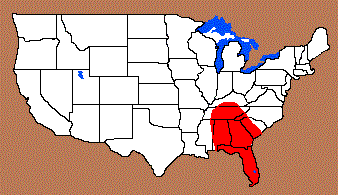
Related / Associated Points:
Dalton Additional Comments:
This type has been recognized as an exhausted Dalton point. It has been argued by Farr (2006) that the use of this type should be discontinued. This raises a great debate in
typology. Some argue that any type which has consistent morphology and differs from any other type should have a unique name. This type, under that argument, this type should retain it's name and be seen as a
unique type that has constant characteristics. Other argue that a unique type should retain it's name through-out the life-cycle of the point. This is because a point will have
different characteristics when it is new, re-sharpened, or exhausted. The naming debate boils down to the purpose of naming points. Is it a way to catalog points, or is it a way to see the changes in the
technology. I feel that the greatest use of a name is to identify changes of technology. The use of proper names helps building clusters which show us the concentrations of technology and how this
technology spreads out from the core areas. Because of this, on this website, this type will be listed as an exhausted type. This does not change the uniqueness of this point, but this website is looking
at the distribution of the technology and exhausted types will not be included in clusters and technology distributions.
For more examples please see other website listed below. Pictures Provided By:
Eric Ellis
Steve Blazina
William Mints
Dan Brymer
Jeff Whitfield
Windy City Artifacts
Special thanks to:
Loyd Doty for insightful information regarding this type.
References: (See Reference Page, Entry Number):
23, 30, 58, 92
Other points in this Cluster:
Point Validity: Exhausted Type
Bullen was a distinguished
anthropologist and Curator Emeritus of the Florida Museum of Natural History. He was dedicated to identifying and typing projectile points from Florida. This point was named in a professional publication and is professionally recognized, but is seen as an exhausted type (see additional comments).
.
Age Details:
Marianna Projectile Point, Marianna Arrowhead
